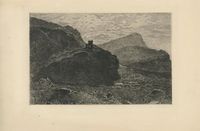Annotation:Muschats Cairn
Back to Muschats Cairn
MUSCHATS CAIRN. Scottish, Reel. G Major. Standard tuning (fiddle). AAB. Composed by James Porteous, Applegarth, Dumfriesshire (c. 1762-1847). According to the Scottish Music Index [1] Porteous received some tutilage from Nathaniel gow in Edinburgh, and was on cordial terms with Niel Gow (an elderly man at the time). He returned to Dumfriesshire to work as a miller and farmer at Knockhill Mill, Hoddam, and acquired the sobriquet "The Musical Miller of Annadale." He is said to have been sociable and kindly. In 1820 he published a collection of his compositions (strathspeys, reels and jigs). "Mysteriously," notes the Scottish Music Index, "a second edition, published a year after the first contains the same music but with an almost complete set of new titles. No explanation for this has so far been suggested."

The story of Muschat's Cairn is told in Cassells' Old and New Edinburgh: Its History, Its People, and Its Places.
MUSCHATS CAIRN. Terrible schemes occupied Nichol Muschat, his brother, and his sister-in-law, together with liurn-bank, “in the Christian city of Edinburgh, during a course of many months, without any one, to appearance, ever feeling the slightest compunction towards the poor woman, though it is admitted she loved her husband, and no real fault on her side has ever been insinuated.” At length it would seem that Nicol, infatuated and lured by evil fate, at the suggestion of “the devil, that cunning adversary ”—as his confession has it—borrowed a knife, scarcely knowing for what purpose, and, inviting his unsuspecting wife to walk with him as far as Duddingston one night, cut her throat near the line of trees that marked the Duke’s Walk. He then rushed in a demented state to tell his brother what he had done, and thereafter sank into a mood of mind that made all seem blank to him. Next morning the unfortunate victim was found “with her throat cut to the bone,” and many other wounds received in her dying struggle. In the favourite old Edinburgh religious tract, which narrates the murderous story, in telling where he went before doing the deed, he says that he passed “through the Tirlies,” at the end of a lane which was near the Meadows. The entrance to the Park, near the Gibbet Fall, was long known as “the Tirlies,” implying a sort of stile. Nicol Muschat was tried, and confessed all. He was hanged, on the 6th of the ensuing January in the Grassmarket, while his associate 1'urnbank was declared infamous, and banished; and the people, to mark their horror of the event, in the old Scottish fashion raised a cairn on the spot where the murder was perpetrated, and it has ever since been a well-remembered locality. The first cairn was removed during the formation of a new footpath through the park, suggested by Lord Adam Gordon, who was resident at Holyrood House in 1789, when Commander of the Forces in Scotland; but from a passage in the II cckly Journal we find that it was restored in 1023 by a cairn near the east gate and close to the north wall. “The original cairn is said to have been several paces farther west than the present one. the stones of which were taken out of the old wall when it was pulled down to give place to the new gate that was constructed previous to the late royal visit”—that of George IV.
Source for notated version:
Printed sources: MacDonald (The Skye Collection), 1887; p. 102.
Recorded sources:
See also listing at:
Alan Snyder's Cape Breton Fiddle Recordings Index [2]
